Centauri Dreams
Imagining and Planning Interstellar Exploration
Mapping the Boundary of the Heliosphere
Between the Solar System and interstellar space is a boundary layer called the heliosheath. Or maybe I should define this boundary as being between the inner, planetary part of the Solar System and interstellar space. After all, we consider the Oort Cloud as part of our own system, yet it begins much further out. Both Voyagers have crossed the region where the Sun’s heliosphere ends and interstellar space begins, while they won’t reach the Oort, by some estimates, for another 300 years.
The broader region is called the heliopause, a place where the outflowing solar wind of protons, electrons and alpha particles (two protons and two neutrons tightly bound) encounters what we can call the interstellar wind, itself pushing up against the heliosphere and confining the solar wind-dominated region to a bubble. We now learn that this boundary region has been mapped, showing interactions at the interface.
A paper describing this feat has now appeared, with Dan Reisenfeld (Los Alamos National Laboratory) as lead author. Says Reisenfeld:
“Physics models have theorized this boundary for years. But this is the first time we’ve actually been able to measure it and make a three-dimensional map of it.”
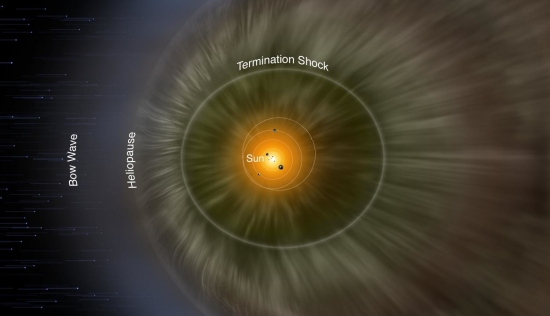
Image: A diagram of our heliosphere. For the first time, scientists have mapped the heliopause, which is the boundary between the heliosphere (brown) and interstellar space (dark blue). Credit: NASA/IBEX/Adler Planetarium.
Riesenfeld and team used data from IBEX, the Interstellar Boundary Explorer satellite, which orbits the Earth but detects energetic neutral atoms (ENAs) from the zone where solar wind particles collide with those of the interstellar wind. Reisenfeld likens the process to bats using sonar, with IBEX using the solar wind as the outgoing signal and mapping the return signal, which varies depending on the intensity of the solar wind striking the heliosheath. Changes in the ENA count trigger the IBEX detectors.
“The solar wind ‘signal’ sent out by the Sun varies in strength, forming a unique pattern,” adds Reisenfeld. “IBEX will see that same pattern in the returning ENA signal, two to six years later, depending on ENA energy and the direction IBEX is looking through the heliosphere. This time difference is how we found the distance to the ENA-source region in a particular direction.”
The IBEX data cover a complete solar cycle from 2009 through 2019. We learn that the minimum distance from the Sun to the heliopause is about 120 AU in the direction facing the interstellar wind, while in the opposite direction, we see a tail that extends to at least 350 AU, which the paper notes is the distance limit of the measurement technique. The asymmetric shape is striking. From the paper’s abstract:
As each point in the sky is sampled once every 6 months, this gives us a time series of 22 points macropixel-1 on which to time-correlate. Consistent with prior studies and heliospheric models, we find that the shortest distance to the heliopause, dHP, is slightly south of the nose direction (dHP ~ 110-120 au), with a flaring toward the flanks and poles (dHP ~ 160-180 au).
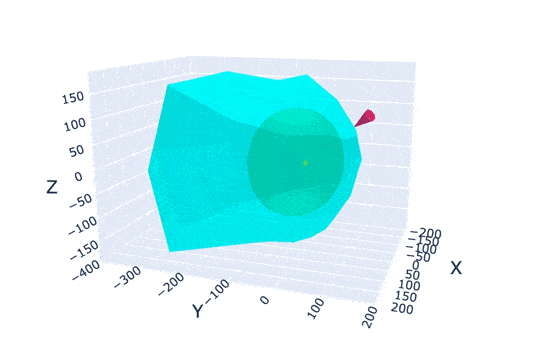
Animation: The first three-dimensional map of the boundary between our solar system and interstellar space—a region known as the heliopause. Credit: Reisenfeld et al
The data make it clear that interactions between the solar wind and the interstellar medium occur over distances much larger than the size of the Solar System. It’s also clear that because the solar wind is not steady, the shape of the heliosphere is ever changing. A ‘gust’ of solar wind causes the heliosphere to inflate, with surges of neutral particles along its outer boundary, while lower levels of solar wind cause a contraction that is detected as a concurrent diminution in the number of neutral particles.
IBEX has been a remarkably successful mission, with a whole solar cycle of observations now under its belt. As we assimilate its data, we can look forward to IMAP — the Interstellar Mapping and Acceleration Probe, which is scheduled to launch in late 2024 and should enable scientists to extend the solid work IBEX has begun.
The paper is Reisenfeld et al., “A Three-dimensional Map of the Heliosphere from IBEX,” Astrophysical Journal Supplement Series Vol. 254, No. 2 (2021) Abstract. The paper is part of a trio of contributions entitled A Full Solar Cycle of Interstellar Boundary Explorer (IBEX) Observations, available here.

Brown Dwarfs & Rogue Planets as JWST Targets
About 1,000 light years away in the constellation Perseus, the stellar nursery designated NGC 1333 is emerging as a priority target for astronomers planning to use the James Webb Space Telescope. Brown dwarfs come into play in the planned work, as do the free-floating ‘rogue’ planets we discussed recently. For NGC 1333 is a compact, relatively nearby target, positioned at the edge of a star-forming molecular cloud. It’s packed with hundreds of young stars, many of them hidden from view by dust, a venue in which to observe star formation in action.
Hoping to learn more about very low mass objects, Aleks Scholz (University of St Andrews, UK) lays out plans for using JWST to chart the distinctions between objects that emerge out of gravitational collapse of gas and dust clouds, and objects that grow through accretion inside a circumstellar disk. Says Scholz:
“The least massive brown dwarfs identified so far are only five to 10 times heftier than the planet Jupiter. We don’t yet know whether even lower mass objects form in stellar nurseries. With Webb, we expect to identify cluster members as puny as Jupiter for the first time ever. Their numbers relative to heftier brown dwarfs and stars will shed light on their origins and also give us important clues about the star formation process more broadly.”
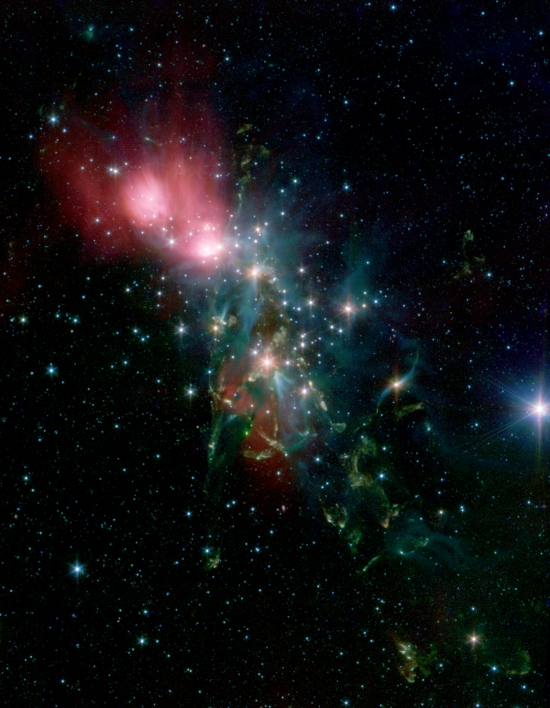
Image: Scientists will use Webb to search the nearby stellar nursery NGC 1333 for its smallest, faintest residents. It is an ideal place to look for very dim, free-floating objects, including those with planetary masses. Credit: NASA/JPL-Caltech/R. A. Gutermuth (Harvard-Smithsonian CfA).
Flying aboard JWST is an instrument called the Near Infrared Imager and Slitless Spectrograph (NIRISS), which Scholz and colleagues will use to analyze the temperature and composition of low-mass objects like these. It is the absorption signature of a particular object, especially water and methane molecules, that will be critical for the work. The advantage of the NIRISS instrument is that it can provide simultaneous spectrographic data on dozens of objects, shortening and simplifying the observational task. One of Scholz’ team, Ray Jayawardhana (Cornell University) has been involved in JWST instrumentation since 2004, and was active in the design and development of NIRISS.
Unable to sustain hydrogen fusion, a brown dwarf may have a mass between 1% and 8% that of the Sun. Most light emitted by these objects is in the infrared, and the already tricky targets are at the top of the size range in this study. Investigating free-floating planets takes us to another level, and even with that in mind, the distinction between a brown dwarf and a giant planet can be blurry. Koraljka Muzic (University of Lisbon), also on Scholz’ team, explains:
“There are some objects with masses below the 10-Jupiter mark freely floating through the cluster. As they don’t orbit any particular star, we may call them brown dwarfs, or planetary-mass objects, since we don’t know better. On the other hand, some massive giant planets may have fusion reactions. And some brown dwarfs may form in a disk.”
Looking through Scholz’ publication list, I noticed a recent paper (“Size and structures of disks around very low mass stars in the Taurus star-forming region” — citation below) that notes the challenge to planet formation models posed by the structure of disks around such stars.
In particular, several giant planets have been found around brown dwarfs, leaving open the question of whether they formed as binary companions or as planets. If the latter, models of planetesimal accretion are hard pressed to explain the process in this environment. The movement of dust presents a problem:
Different physical processes lead to collisions of particles and their potential growth, such as Brownian motion, turbulence, dust settling, and radial drift… All of these processes have a direct or indirect dependency on the properties of the hosting star, such as the temperature and mass. For instance, from theoretical calculations, settling and radial drift are expected to be more efficient in disks around VLMS [Very Low Mass Stars] and BDs [Brown Dwarfs], with BD disks being 15-20% flatter and with radial drift velocities being twice as high or even more in these disks compared to T-Tauri disks…. With radial drift being a more pronounced problem in disks around BDs and VLMS, it is still unknown how this barrier of planet formation is overcome in these environments where the disks are more compact, colder, and have a lower mass.
The paper on the Taurus star-forming region draws on data from ALMA (Atacama Large Millimeter/submillimeter Array), and notes the problems that we can hope JWST will alleviate:
Detection rate of substructures: millimeter dust substructures were directly detected in only 50% of the targets in our sample. Our results suggest that the detection of substructures in disks around VLMS is limited by angular resolution and sensitivity, since the dust radial extent is very small and these disks are also very faint. Deep, high angular resolution observations over a non-brightness biased sample of VLMS should confirm the ubiquity of substructures in these disks.
This is going to be an exciting area of research. As the paper points out, for every ten stars that form in our galaxy, somewhere between two and five brown dwarfs also form, and we already know that low-mass M-dwarfs account for as much as 75 percent of the Milky Way’s stars. When massive objects form around or near brown dwarfs, we are challenged to adjust our models of interactions within the disk and re-consider models of gravitational collapse. Interesting brown dwarf issues await JWST if we can just get it into operation.
The Scholz paper cited above is “Size and structures of disks around very low mass stars in the Taurus star-forming region,” Astronomy & Astrophysics Vol. 645, A139 (January 2021). Abstract.

NEO Surveyor: Proposed Asteroid Surveillance Mission
Near-Earth Object Surveyor is a proposed space telescope working at infrared wavelengths, an instrument that just completed a successful mission review and now moves on to the next phase of mission development. In NASA parlance, the upcoming Key Decision Point-B moves into Preliminary Design territory. Getting a spacecraft from concept to flight is a long process, but let’s back out to the broader picture.
Planetary defense is all about finding objects that could impact the Earth with serious consequences. That means setting size targets, and on that score, we’re making progress. In 2010, NASA announced that it had identified 90 percent of all Near Earth Objects larger than 1,000 meters. That moved us to the next target, NEOs larger than 140 meters in size, a goal set by the National Aeronautics and Space Administration Act of 2005. JPL now says about 40% of NEOs within this size range have been identified.
So with this work in progress, what does NEO Surveyor bring to the table? For one thing, it makes it possible to discover asteroids on dangerous trajectories much faster than current methods allow, by including objects that could approach the Earth from directions close to the Sun, a blind spot for ground-based observatories. Amy Mainzer is survey director for NEO Surveyor at the University of Arizona:
“By searching for NEOs closer to the direction of the Sun, NEO Surveyor would help astronomers discover impact hazards that could approach Earth from the daytime sky. NEO Surveyor would also significantly enhance NASA’s ability to determine the specific sizes and characteristics of newly discovered NEOs by using infrared light, complementing ongoing observations being conducted by ground-based observatories and radar.”

Image: NEO Surveyor is a new mission proposal designed to discover and characterize most of the potentially hazardous asteroids that are near the Earth. Credit: NASA/JPL-Caltech.
It’s worth remembering that while there are currently no impact threats in the catalog for this century, unknown objects still pose problems. Nobody tracked the Chelyabinsk impactor of 2013, reminding us of the dangers of complacency and the need for better sensors, like those NEO Surveyor would deploy in the infrared. The Chelyabinsk object was about 17 meters in size, well below what we are currently cataloging.
But we continue to make progress. Mike Kelley, a NEO Surveyor program scientist at NASA headquarters, believes the spacecraft could bring the catalog of 140-meter objects to 90 percent completion within ten years of launch (in 2026, if NEO Surveyor continues to move on track).
Meanwhile, we should keep in mind missions further along in the pipeline. The Double Asteroid Redirection Test (DART) mission is up for launch later this year. This one is about active planetary defense, with the plan of using a kinetic impactor to change an asteroid’s trajectory. The target is a binary near-Earth asteroid called (65803) Didymos; more specifically, DART will hit Didymos’ moon Dimorphos head on in the fall of 2022.
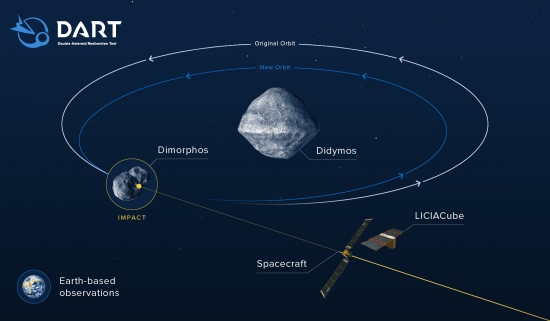
Image: Illustration of how DART’s impact will alter the orbit of Dimorphos (formerly called “Didymos B”) about Didymos. Telescopes on Earth will be able to measure the change in the orbit of Dimorphos to evaluate the effectiveness of the DART impact. Credit: NASA/JPL.
Interestingly, about one sixth of the known near-Earth asteroid (NEA) population are binary or multiple-body systems. Didymos and Dimorphos are separated by about one kilometer, with the 160-meter moon tidally locked to the 780 meter primary. Let’s also note the international aspects of DART, for the mission will work hand in glove with an Italian cubesat called LICIA (Light Italian CubeSat for Imaging of Asteroid) that will observe the impact ejecta, while the European Space Agency’s Hera mission will make a post-impact survey several years after the event.
Asteroid threat mitigation is indeed a global concern, but we’re beginning to experiment with deflection strategies using actual missions. The mission page for DART explains the plan this way:
The DART demonstration has been carefully designed. The impulse of energy that DART delivers to the Didymos binary asteroid system is low and cannot disrupt the asteroid, and Didymos’s orbit does not intersect Earth’s at any point in current predictions. Furthermore, the change in Dimorphos’s orbit is designed to bring its orbit closer to Didymos. The DART mission is a demonstration of capability to respond to a potential asteroid impact threat, should one ever be discovered.
We can hope we’ll never have to use the DART strategy — or others that are under active consideration — to adjust the trajectory of a major impactor, but we obviously need to have the tools available just in case. The need to conduct such tests and to maintain active surveillance as a means of planetary defense is a driver for space technologies we shouldn’t overlook. The capability of adjusting orbits much further from home is a spur toward exploration and surveillance throughout the system.

A Visualization of Galactic Settlement
When the question of technosignatures at Alpha Centauri came up at the recent Breakthrough Discuss conference, the natural response was to question the likelihood of a civilization emerging around the nearest stars to our own. We kicked that around in Alpha Centauri and the Search for Technosignatures, focusing on ideas presented by Brian Lacki (UC-Berkeley) at the meeting. But as we saw in that discussion, we don’t have to assume that abiogenesis has to occur in order to find a technosignature around any particular star.
Ask Jason Wright (Penn State) and colleagues Jonathan Carroll-Nellenback and Adam Frank (University of Rochester) as well as Caleb Scharf (Columbia University), whose analysis of galaxies in transition has now produced a fine visual aid. Described in a short paper in Research Notes of the AAS, the simulation makes a major point: If civilizations last long enough to produce star-crossing technologies, then technosignatures may be widespread, found in venues across the galaxy.
The simulation depicts the expansion of a technological civilization through the Milky Way, created along lines previously described in the literature by the authors (citation below). What we are looking at is the transition between a Kardashev Type II civilization (here defined as a species using its technology in a significant fraction of the space around the host star), and a Type III, which has spread throughout the galaxy. Wright has argued in earlier work that, contra Sagan and others, this might be a fast process considering the motions of stars themselves, which would overcome the inertia of slower growing settlements and boost expansion rates.

Image: This is Figure 1 from the paper. Caption: A snapshot of the animation showing the settlement of the galaxy. White points are unsettled stars, magenta spheres are settled stars, and white cubes represent a settlement ship in transit. The spiral structure is due to galactic shear as the settlement wave expands. The full, low-resolution video is available in the HTML version of this research note, and a high resolution version can be found archived at ScholarSphere (see footnote 7). Credit: Wright et al.
And here is the animation, also available at https://youtu.be/hNMgtRf0GOg.
Issues like starship capabilities and the lifetime of colonies come into play, but the striking thing is how fast galactic settlement occurs and how the motions of stars factor into the settlement wave. Naturally, the parameters are everything, and they’re interesting:
- Ships are launched no more frequently (from both the home system and all settlements) than every 0.1 Myr — every 100,000 years;
- Technology persists in a given settlement for 100 million years before dying out;
- Ship range is roughly 3 parsecs, on the order of 10 light years.
- Ship speeds are on the order of 10 kilometers per second; in other words, Voyager-class speeds. “We have chosen,” the authors say, “ship parameters at the very conservative end of the range that allows for a transition to Type iii.”
All told, the simulation covers 1 billion years, and about it, the authors say that:
…it shows how rapidly expansion occurs once the settlement front reaches the galactic bulge and center. The speed of the settlement front depends strongly on the ratio of the maximum ship range to the average stellar separation. Here, we deliberately set this ratio to near unity at the stellar density of the first settlement, so the time constant on the settlement growth starts out small but positive. Eventually, the inward-moving part of the front encounters exponentially increasing stellar densities and accelerates, while the outward-moving part stalls in the rarer parts of the galaxy. Note that at around 0:33 a halo star becomes settled, and at 0:35 it settles a disk star near the top of the movie and far from the other settlements. This creates a second settlement front that merges with the first…
It comes as no surprise that the central regions of galaxies, thick with stars, are places that favor interstellar migration. Can a technological culture survive against ambient conditions in a galactic bulge? If so, these regions are logical SETI targets, and perhaps the most likely to yield a technosignature. The idea has synergy with other observations we are already interested in making, as for example studies of the supermassive black hole at galactic center.
So even slow — very slow — ships will fill a galaxy.
The paper is Wright et al., “The Dynamics of the Transition from Kardashev Type II to Type III Galaxies Favor Technosignature Searches in the Central Regions of Galaxies,” Research Notes of the AAS Vol. 5, No. 6 (June 2021). Abstract. The 2019 paper is Carroll-Nellenback et al., “The Fermi Paradox and the Aurora Effect: Exo-civilization Settlement, Expansion, and Steady States,” Astronomical Journal Vol. 158, No. 3 (2019). Abstract. This earlier paper is a storehouse of references and insights into the likelihood of interstellar settlement and spread.

Liquid Water on a Free Floating Planet’s Moon?
As we learn more about how planetary systems form, it’s becoming accepted that a large number of planets are being ejected from young systems because of their interactions with more massive worlds. I always referred to these as ‘rogue planets’ in previous articles on the subject, but a new paper from Patricio Javier Ávila (University of Concepción, Chile) and colleagues makes it clear that the term Free Floating Planet (FFP) is now widespread. A new acronym for us to master!
There have been searches to try to constrain the number of free floating planets, though the suggested ranges are wide. Microlensing seems the best technique, as it can spot masses we cannot otherwise see through their effect on background starlight. Of these, the estimates come in at around 2 Jupiter-mass planets and 2.5 terrestrial-class rocky worlds per star that have been flung into the darkness. This is a vast number of planets, but we have to be wary of mass uncertainties, as the cut-off between planet and brown dwarf (usually around 13 Jupiter masses) comes into play.
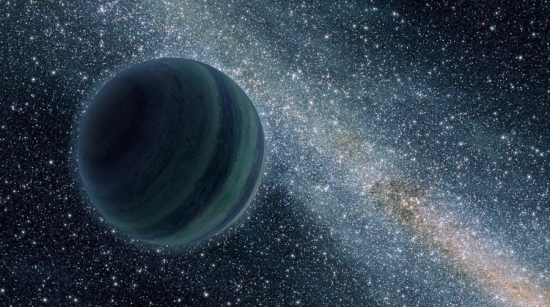
Image: An artist’s conception of a free floating planet. Credit: JPL/Caltech.
Any chance for life on a world like this? It’s hard to see how unless it’s something exotic indeed, but it’s Friday, so let’s play around with the idea. A major paper on rogue worlds is a 1999 discussion in Nature by David Stevenson (Caltech), which assumes a hydrogen-rich atmosphere. I’m just going to pull this out of the abstract before moving on to the Ávila paper:
Pressure-induced far-infrared opacity of H2 may prevent these bodies from eliminating internal radioactive heat except by developing an extensive adiabatic (with no loss or gain of heat) convective atmosphere. This means that, although the effective temperature of the body is around 30 K, its surface temperature can exceed the melting point of water. Such bodies may therefore have water oceans whose surface pressure and temperature are like those found at the base of Earth’s oceans. Such potential homes for life will be difficult to detect.
To say the least. Let’s also note a later paper by Steinn Sigurðsson and John Debes that has shown that among terrestrial class planets ejected from their stars, a good number may retain a lunar-sized moon. Citations for both these papers are below.
But let’s think bigger. Ávila and colleagues go after Jupiter-sized worlds with large, terrestrial-sized moons (far larger than any we see in our Solar System, where Ganymede, larger than Mercury but much smaller than Earth, reigns supreme). They model the chemical composition and evolution of CO2 and water in an attempt to discover the kind of atmosphere that would allow liquid water on the surface. CO2 is found to produce more effective atmospheric opacity (governing atmospheric absorption) than Stevenson’s choice of molecular hydrogen.
From the paper:
…to the best of our knowledge, there are no detailed models of the chemical evolution of the atmosphere of a moon orbiting an FFP. Within this context, we introduce here an atmospheric model to tackle this limitation. We assume that in the absence of radiation from a companion star, the tidal and the radiogenic heating mechanisms represent the main sources of energy to maintain and produce an optimal range of surface temperatures.
The authors simulate the atmosphere of an Earth-sized moon in an eccentric orbit around a gas giant, analyzing its thermal structure and determining the mechanisms that can keep it warm. The assumption is that carbon dioxide accounts for 90% of the moon’s atmosphere. The model relies on radiogenic heating along with tidal factors as the main energy sources while invoking an atmosphere under changing conditions of cosmic ray ionization, chemistry, pressure and temperatures.
In a setting like this, the cosmic-ray ionization rate (CRIR) drives chemistry in the atmosphere. A bit more on this:
Due to the absence of impinging radiation, the time-scale of water production is driven by the efficiency of cosmic rays in penetrating the atmosphere. Higher CRIRs reduce the water formation time-scale when compared to low-CRIR models, implying that they play a key role in the chemical evolution, by enhancing the chemical kinetics. However, due to the attenuation of cosmic rays, in the lower layers of the atmosphere, the water production is also affected by the density structure, that determines the integrated column density through the atmosphere. This causes an altitude-dependent abundance of water as well as of some of the other chemical species, as CO, H2 and O2.
The authors’ model assumes an initial 10% molecular hydrogen and measures changes depending on atmospheric pressure, semi-major axis and eccentricity, the latter generating tidal heating. In the best scenario, we wind up with an amount of water on the surface of the moon that is about 10,000 times smaller than the volume of Earth’s oceans, but 100 times larger than found in Earth’s atmosphere. Thus we have a conceivable way to keep water a liquid on the surface, offering the possibility of prebiotic chemistry:
“Under these conditions, if the orbital parameters are stable to guarantee a constant tidal heating, once water is formed, it remains liquid over the entire system evolution, and therefore providing favourable conditions for the emergence of life.
Keeping that orbit eccentric enough to produce the needed tidal forces is a challenge. The authors’ research indicates that while moons around ejected gas giants may exist up to 0.1 AU from the planet, closer orbits in the range of ≲ 0.01 AU are more probable (Jupiter’s largest moons are within 0.01 AU). Is a single moon in this configuration not going to circularize its orbit, or can earlier orbital resonances survive the ejection? A good science fiction writer should have a go at this scenario to see what’s possible.
The paper is Avila et al., “Presence of water on exomoons orbiting free-floating planets: a case study,” International Journal of Astrobiology published online 08 June 2021 (full text). The Sigurðsson and Debes paper is Debes & Sigurðsson, “The Survival Rate of Ejected Terrestrial Planets with Moons,” Astrophysical Journal Vol. 668, No. 2 (2 October 2007) L 167 (full text). The Stevenson paper is “Life-sustaining planets in interstellar space?” Nature 400 (6739):32 (1999). Abstract.

A Rapidly Growing Catalog of Fast Radio Bursts
Hard to believe that Fast Radio Bursts (FRBs) were only discovered in 2007, as it seems we’ve been puzzled by them for a lot longer. Thus far about 140 FRBs have been detected, but now we have news that the Canadian Hydrogen Intensity Mapping Experiment (CHIME) has pulled in a total of 535 new fast radio bursts in its first year of operation between 2018 and 2019. The catalog growing from this work was presented this week at the annual meeting of the American Astronomical Society.
“Before CHIME, there were less than 100 total discovered FRBs; now, after one year of observation, we’ve discovered hundreds more,” says CHIME member Kaitlyn Shin, a graduate student in MIT’s Department of Physics. “With all these sources, we can really start getting a picture of what FRBs look like as a whole, what astrophysics might be driving these events, and how they can be used to study the universe going forward.”

Image: The large radio telescope CHIME, pictured here, has detected more than 500 mysterious fast radio bursts in its first year of operation, MIT researchers report. Credit: Courtesy of CHIME.
CHIME involves four cylindrical radio antennas that MIT describes as “roughly the size and shape of snowboarding half-pipes” located in British Columbia, and operated by the National Research Council of Canada. A correlator instrument — a digital signaling processor — digs through data from the stationary array at a rate of 7 terabits per second, allowing it to detect FRBs at a thousand times the pace of conventional radio telescopes.
We learn, for one thing, that FRBs are common, and frequent. Kiyoshi Masui (MIT) presented the catalog to conference goers on Wednesday the 9th:
“That’s kind of the beautiful thing about this field — FRBs are really hard to see, but they’re not uncommon. If your eyes could see radio flashes the way you can see camera flashes, you would see them all the time if you just looked up.”
It becomes clear from these data that the FRBs detected in the first year were evenly distributed in space, appearing in all parts of the sky. Their rate is thus far calculated to be 800 per day across the entire sky, a figure that is considered the most precise estimate of the phenomena’s occurrence that has yet been presented. Most bursts appear to have originated within distant galaxies, meaning they were highly energetic.
Two categories of FRB also emerge: Those that repeat and those that do not. 18 of the CHIME sources do repeat, with the rest one-time events. Among the repeating signals, each burst lasts slightly longer and emits more focused radio frequencies then bursts from single, non-repeating FRBs. We seem to be looking at two different kinds of astrophysical sources, or at least separate mechanisms, and it will be a goal of future data collection to clarify the differences between the two.
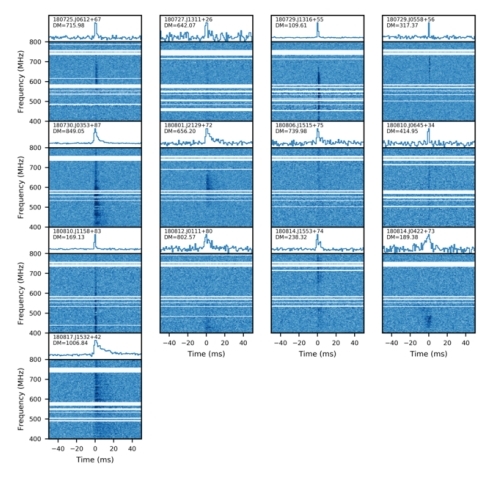
Image: The first 13 FRBs found by CHIME/FRB (from CHIME/FRB Collaboration, 2019, Nature, 566, 230). In this plot, the effects of dispersion have been removed from each source. Credit: CHIME.
While researchers work to learn what could cause such bright, fast signals, it’s fascinating to compare the FRB work with the use of supernovae as ‘standard candles.’ Evidence for the accelerating expansion of the universe was found by such measurements. Can FRBs be used as standard candles for other kinds of detections? Each FRB yields information about its propagation in terms of how gas and matter are distributed along the way to us. Kaitlyn Shin refers to the possibility of using them as “cosmological probes,” a potential enhanced by this new and growing catalog.


